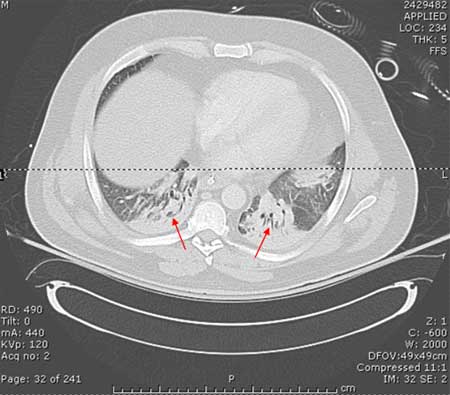Summary
Definition
History and exam
Key diagnostic factors
- cough with increasing sputum production
- dyspnoea
- fever
- presence of risk factors
Other diagnostic factors
- chest pain
- asymmetrical expansion of the chest
- diminished resonance
- abnormal auscultatory findings
- tachycardia
- malaise/anorexia
Risk factors
- poor infection control/hand hygiene
- intubation and mechanical ventilation
- multidrug-resistant bacteria
- aspiration
- acid-suppression drugs
- depressed consciousness
- chest or upper abdominal surgery
Diagnostic investigations
1st investigations to order
- oxygen saturations
- chest x-ray
- full blood count
- blood gas
- C-reactive protein
- renal and liver function tests (LFTs)
- culture of sputum, nasopharyngeal swab, or tracheal aspirate samples
Investigations to consider
- CT scan chest
- chest ultrasound
- thoracocentesis and pleural fluid culture
- urine antigen testing
- PCR and/or serological tests including for SARS-CoV-2
- serum procalcitonin
Treatment algorithm
Contributors
Expert advisers
Jonathan Bennett, MD
Honorary Professor of Respiratory Sciences
University of Leicester
Respiratory Consultant
Glenfield Hospital
Leicester
UK
Biography
JB is deputy medical director, RCP Invited Service Reviews, and speaker at national society meetings including (eg., British Thoracic Society, Primary Care Respiratory Society, and Society for Cardiothoracic Surgery.
Disclosures
JB declares that he has no competing interests.
Claire Vella, MD, MRCP
Consultant Respiratory Physician
Glenfield Hospital
University Hospitals of Leicester NHS Trust
Leicester
UK
Disclosures
CV declares that she has no competing interests.
Acknowledgements
BMJ Best Practice would like to gratefully acknowledge the previous expert contributor, whose work has been retained in parts of the content:
Forest W. Arnold, DO MSc, FIDSA
Associate Professor of Medicine
Division of Infectious Diseases
Department of Medicine
School of Medicine
University of Louisville
Louisville
KY
Disclosures
FWA declares that he has no competing interests.
Peer reviewers
Jeremy Brown, MBBS, MRCP, PhD
Professor of Respiratory Infection/Honorary Consultant
University College London
London
UK
Disclosures
JB was a member of the NICE pneumonia guidelines committee.
Peer reviewer acknowledgements
BMJ Best Practice topics are updated on a rolling basis in line with developments in evidence and guidance. The peer reviewers listed here have reviewed the content at least once during the history of the topic.
Disclosures
Peer reviewer affiliations and disclosures pertain to the time of the review.
References
Key articles
Kalil AC, Metersky ML, Klompas M, et al. Management of adults with hospital-acquired and ventilator-associated pneumonia: 2016 clinical practice guidelines by the Infectious Diseases Society of America and the American Thoracic Society. Clin Infect Dis. 2016;63:e61-e111.Full text Abstract
National Institute for Health and Care Excellence. Pneumonia in adults: diagnosis and management. Jul 2022 [internet publication].Full text
Torres A, Niederman MS, Chastre J, et al. International ERS/ESICM/ESCMID/ALAT guidelines for the management of hospital-acquired pneumonia and ventilator-associated pneumonia: guidelines for the management of hospital-acquired pneumonia (HAP)/ventilator-associated pneumonia (VAP) of the European Respiratory Society (ERS), European Society of Intensive Care Medicine (ESICM), European Society of Clinical Microbiology and Infectious Diseases (ESCMID) and Asociación Latinoamericana del Tórax (ALAT). Eur Respir J. 2017 Sep;50(3):1700582.Full text Abstract
National Institute for Health and Care Excellence. Pneumonia (hospital-acquired): antimicrobial prescribing. Sep 2019 [internet publication].Full text
Reference articles
A full list of sources referenced in this topic is available here.
Use of this content is subject to our disclaimer
